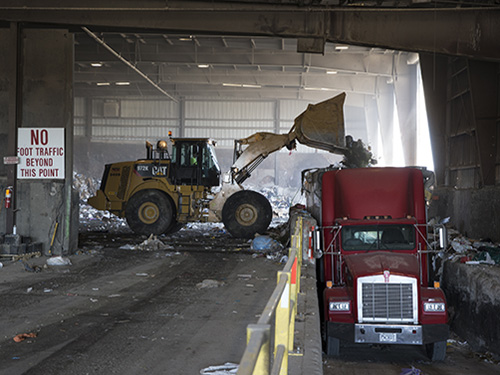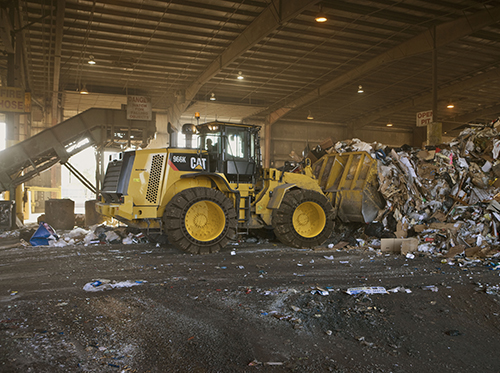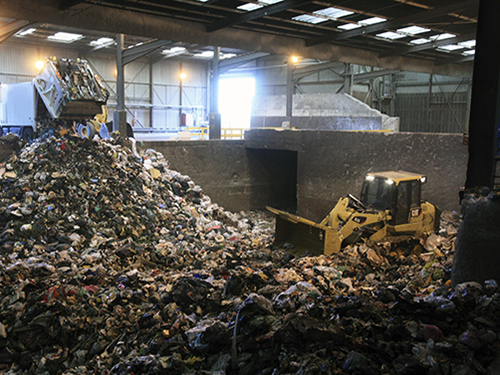Transfer Station and Material Recovery Facility Solutions
READY TO KEEP YOUR OPERATION FLOWING
Separating. Sorting. Stockpiling. You do it all—and you need equipment, expertise and support ready for whatever challenges tomorrow brings. We help you get the job done efficiently, safely and at the lowest possible cost.

LOADERS READY FOR THE JOB AT HAND
Transfer stations and material recovery facilities can be harsh environments—and that means you need machines ready to tackle tough jobs with minimal downtime. Cat® wheel loaders are purpose-built for your application, and they come direct from the factory with the right configurations for the job.
PURPOSE-BUILT CONFIGURATION
Choose from a complete range of optional guarding to protect both you and your machine from the harsh environment of industrial applications. The guarding is purpose-built to protect the major components and systems, keeping you on the job and maximizing productivity.
WASTE
In the harsh environment of a waste handling application, you need a wheel loader designed for the job. The waste package is specifically designed to protect all major components and systems for use in wast handling applications.
SCRAP
Cat® wheel loaders are ready for whatever job you have in your yard, from unloading and sorting, to separating and site maintenance. They load trucks, rail cars and barges around the world.
BULK MATERIAL HANDLING
When working the hold, use high-efficiency Cat wheel loaders to distribute material quickly between the extremities and the loading areas, filling void space to reduce cost per ton.

5 SIMPLE WAYS TO IMPROVE YOUR OPERATION
If you're like most companies, you can probably think of numerous places to make improvements in your operation. But trying to do too much can be a recipe for failure. So where should you concentrate your efforts? We talked to operations managers at several landfills, transfer stations and material recovery facilities, and they agree focusing on these five areas is the best way to start.
1. PUT SAFETY FIRST—EVERY DAY.
Simply reminding employees to “stay safe” as they head out on the job isn’t enough. If your target is zero incidents or injuries—and it should be—you need to build a culture where every individual buys into that goal. That means giving your people the tools and training to work safely in every situation, as well as the confidence to speak up when something isn’t right. If you don’t have an ongoing safety program in place, now’s the time to get started. Check out the resources available at safety.cat.com.
2. LET YOUR EQUIPMENT HELP YOU CUT COSTS.
While there’s no magic bullet for lowering costs, you may find two solutions in your machines themselves. First, make equipment management a priority. Do the recommended preventive maintenance on schedule. Complete repairs before failure. Require operators to perform machine walkarounds before every shift. (These checklists can help.) And listen to operator feedback about machine performance—they know the equipment best.
Second, consider right-sizing your fleet. As waste streams and peak times change, so do equipment needs. Take a look at your machines and ask yourself (and your team) if they meet the demands of your operation today and tomorrow. You may be able to make changes to improve efficiency and lower fuel costs.
3. INVEST IN YOUR PEOPLE.
Employees who feel valued are employees who give back to your operation. You’ll reap plenty of ROI when you take the time to teach your people safe job procedures, machine and application best practices, and good maintenance techniques. Consider CPR or first responder training, too—you never know when that might pay off in a life saved on the job.
Cross-training is important as well. Encourage employees to take on different roles and responsibilities. Doing so allows them to grow within your company (rather than leaving for other opportunities) and helps you build a pipeline of qualified employees for the future.
4. COMMUNICATE YOUR PLANS.
Do you have plans (and back-up plans) in place for your daily operations? Probably. Have you shared them with your employees and asked for input? That’s where things can fall short. Plans only work when your entire team is on board in executing them, and the key to that is communication. So make your plans, then get your people involved in making them better—and make sure each employee has individual goals in place to help you achieve them.
5. BE A GOOD NEIGHBOR.
Internal improvements are crucial—and so are external relationships. Being seen as a partner in your community means adhering to all regulations and proactively sharing any plans that may affect nearby businesses or homeowners. Dump days, tours, open houses and school visits are all excellent ways to build goodwill. You might also consider regular meetings with haulers or large customers to talk about what’s going well and what you could do differently.
Of course, identifying improvement areas is the easy part. Making changes is more challenging—but the rewards you’ll experience in lower costs, higher productivity and better employee morale are worth the effort. Not sure where to begin? We can help. Caterpillar is the only equipment manufacturer to offer machine, application, maintenance and safety consultation and training specifically for the waste industry. Just talk to your us to get started.

